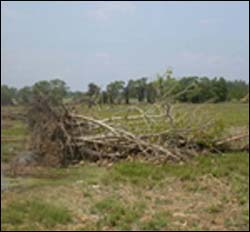Could better mangrove habitats have spared lives in the 2004 tsunami?

Credit: Farid Dahdouh-Guebas
Accounts of the tsunami that killed over a quarter of a million people in Southeast Asia on the 26th of December, 2004, slowly disappear from the media, but the event is nevertheless heavily burned into the memories of those who are directly involved. In the aftermath of the disaster, academics and politicians alike are trying to investigate how the number of casualties could have been reduced and, more important, how such severe damage can be avoided if a tsunami ever strikes again. In an essay published this week in the June 21 issue of Current Biology, a group of researchers recount the first findings arising from their recent assessment of how mangrove ecosystems might have influenced the tsunami’s impacts on coastal communities.
The research represents a collaborative effort, with participants from the Vrije Universiteit Brussel, Belgium; the University of Ruhuna, Sri Lanka; the Kenya Marine and Fisheries Research Institute; and the Institut Français de Pondichéry, India.
Mangrove greenbelts were known to offer some protection against destructive ocean events, such as tsunamis and (far more frequently) tropical cyclones, but they have not always been valued for that function. Economic and political interference, driven by short-term benefit, has been responsible for the destruction of thousands of hectares of mangrove forest (e.g., in East Africa, on the Indian subcontinent, and in Banda Aceh, Indonesia), resulting in the loss of the natural, protective “dyke” function of mangroves in addition to the loss of other services that mangroves provide to local economies and ecosystems. Although many politicians, journalists, and scientists have made post-tsunami statements about the barrier function of mangroves, most have failed to recognize that this function has never actually been investigated in detail.
In their essay, the authors present an account of the first post-tsunami field assessment they’ve undertaken, in Sri Lanka. The researchers investigated the impact of the tsunami at 24 different mangrove sites, comparing the event’s effects to the size, history, and quality of the local mangroves. The researchers found that where mangroves occur, they did in fact offer protection from the tsunami. Mangrove fringes near the water’s edge appeared to take most of the energy from the tsunami waves, and they showed evidence of damage in some cases, but the researchers found few examples of mangrove trees actually being uprooted.
However, mangroves at numerous sites had experienced pre-tsunami degradation. This disruption, resulting from human impact, included “cryptic ecological degradation” (see also Current Biology, March 29, 2005), which involves subtle changes in species composition. From their assessments of the 24 coastal sites, the researchers concluded that even these seemingly minor alterations, which do not necessarily involve a reduction in mangrove area, have had a profound impact on the damage that the 2004 tsunami inflicted on the coastal zone. This puts the drastic clearing of mangroves, and the conversion of mangrove habitats to shrimp farms in other areas, into even starker perspective.
The authors highlight the urgent need for a union between management-driven research (research that specifically focuses on environmental aspects that need to be managed) and research-driven management (management that is based on facts from scientific research). The team emphasizes that an early-warning system for mangrove degradation should be seen as being as important for future protection as are early-warning systems for tsunami arrivals; the authors contend that if put in place, such ecological warning systems, along with the restoration of mangroves and other natural defenses, could be more effective in saving human lives and property.
Media Contact
More Information:
http://www.current-biology.comAll latest news from the category: Ecology, The Environment and Conservation
This complex theme deals primarily with interactions between organisms and the environmental factors that impact them, but to a greater extent between individual inanimate environmental factors.
innovations-report offers informative reports and articles on topics such as climate protection, landscape conservation, ecological systems, wildlife and nature parks and ecosystem efficiency and balance.
Newest articles

Time to Leave Home? Revealed Insights into Brood Care of Cichlids
Shell-dwelling cichlids take intense care of their offspring, which they raise in abandoned snail shells. A team at the Max Planck Institute for Biological Intelligence used 3D-printed snail shells to…

Smart Fabrics: Innovative Comfortable Wearable Tech
Researchers have demonstrated new wearable technologies that both generate electricity from human movement and improve the comfort of the technology for the people wearing them. The work stems from an…

Going Steady—Study Reveals North Atlantic’s Gulf Stream Remains Robust
A study by the University of Bern and the Woods Hole Oceanographic Institution in the USA concludes that the ocean circulation in the North Atlantic, which includes the Gulf Stream,…



